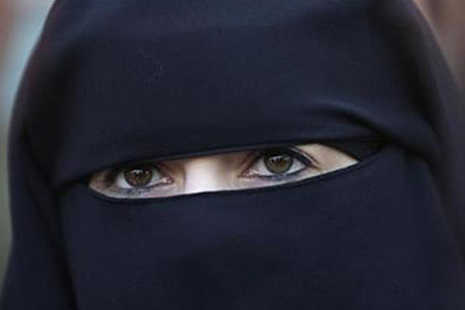
A young women wearing a black burqa which has a separate piece of cloth to cover the head and face in order not to impede the vision of the person wearing it. (Picture: Dawn.com)
Looking into the cultural and social dynamics of the conservative community, a change is visible from one generation to the next—that of choice in burqa. But what does this change from the blue to black burqa signify?
The blue-colored burqa, also referred to as the ‘shuttlecock’, is native to Afghanistan, however, the growing hold of the Taliban in the northern areas contributed to its spread in Pakistan as well. The reason: to increase the level of purdah for girls and women.
“When females wear the blue burqa, you can’t distinguish if she is a 12-year-old child or a 60-year-old grandmother,” says journalist and researcher Ali Arqam.
The blue burqa completely covers the body as a single piece of cloth, compared to the black burqa which is usually in three pieces: the coat, the head covering and the niqab.
In covering women with a single piece of cloth a number of practicalities are left ignored. For example when women step out to buy groceries or run errands and need to use their hands to pick up or carry anything they would have to lift their burqa and hold the items under it, which can be very inconvenient.
Further, the blue-colored light weight cloth flutters, especially during strong winds, and has to be held tightly, sometimes with both hands. With restricted vision and both hands used to hold the burqa in place it leaves women with little, if any, options to be able to do anything else.
In comparison the three-piece coat-styled black burqa has long sleeves and a separate piece to cover the face revealing only the eyes. This makes its easier for the wearer to maneuver themselves in public without impeding vision. The black burqa is also usually made of heavy fabric, which does not allow it to flutter in the wind easily, although this does make the attire much warmer to wear. Despite this setback, the advantages to the black burqa are many.
“I have only tried to wear my mother’s blue burqa once at home and when I did I almost immediately took it off,” says 14-year-old Marium who belongs to a Pashtun household and wanted to only share her first name.
“The cutwork by the eyes, which is meant to permit women wearing the blue burqa to see, actually pricks you and with no other opening it makes it very difficult to breathe,” she adds softly, not wanting to offend her mother.
Marium’s 17-year-old neighbor Faryal got married close to five months ago. Used to wearing the black burqa in her maiden days, the teenage bride felt nauseous for over a month before she managed to get used to the "claustrophobic blue one", she says.
But Faryal did not protest when she learnt she would have to move from the black burqa to the blue one after marriage out of respect for her family and her in-laws, Marium narrates.
There are however others who do not agree that respect for one’s culture means giving up on practicality and fashion.
“Women are treated as the honor of the family in Pashtun community, but as they (women) become more educated, empowered and modernized they continue to cover themselves but in a manner which is more current with the times and yes more fashionable,” says Samar Esapzai who is pursuing a PhD in rural development and gender studies.
Marium, who belongs to a lower middle-class but relatively educated household, is skeptical about agreeing with Esapzai's view on the issue.
“Purdah is part of our culture and our tradition. I am my father’s honor and when I get married I will be my husband’s and his household’s honor. Despite my preference, I’m prepared that I will mostly likely need to wear the blue burqa after marriage and when the time comes I will do the needful.”
Full Story: 'The difference between black and blue'
Source:Dawn


